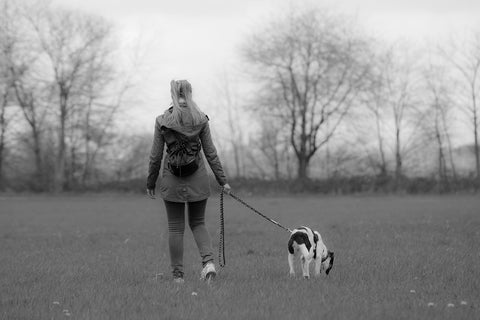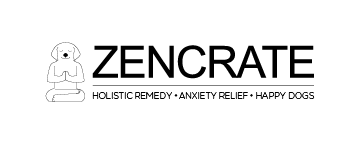“Are you walking him or is he walking you?” Many dog owners have been on the receiving end of this quip while struggling to restrain a wayward dog. Failure to maintain control of your dog on a leash is dangerous for you, your pet, and other dogs or people you may encounter on a walk. The goal of leash training is to achieve “loose leash” while walking, which means your dog stays close enough to you to keep slack in the lead. Leash training a dog takes patience, but the results – a safer, more enjoyable walk and a happy, obedient dog – are well worth the effort.
Choose the Best Leash Option When Leash Training
There are many types and styles of leashes, harnesses, and halters these days making it the decision overwhelming. There is no one-size-fits-all setup for leash training, so you may have to experiment to find the combination that’s right for your dog. In most cases, it’s fine to start with a regular collar and clip-on leash, four to six feet in length.

Caution: Most professional dog trainers warn that you should not use retractable leashes, especially while training. They can actually encourage pulling and lunging by teaching the dog that if he charges ahead, he gets a longer leash. In addition, they pose serious hazards:
- Your dog can get far enough away from you to get himself in real trouble – some retractable leashes are up to 26 feet long.
- The sudden stop when the slack runs out can damage the dog’s neck or spine.
- The leash can break if your dog lunges, or it can slip out of your hands easily.
- You or your dog can become tangled in the line – several people have experienced broken bones or other serious injuries.
Patience Is Key in Leash Training a Dog
Start by introducing the dog to the collar. Let him wear it around the house, especially during play time and mealtime, so he associates the collar with love and tasty food. After a few days of this, clip the leash to the collar and let him wear it inside while you continue this positive reinforcement. For safety reasons, do not let the dog drag the leash around unattended.
Next, it’s time to attach yourself to the leash. Put your hand through the wrist strap and maintain a firm but gentle grip on the leash, and remember to always stay calm but authoritative. Don’t scream at your dog or yank him to heel. Scaring or hurting him creates a negative association with the leash and undermines your efforts.
Start with short, easily attainable goals, like walking 100 yards. When your dog walks with slack in the leash, reward him (see below) and say, “Heel!” or use whatever verbal command you want to associate with the behavior. When he pulls ahead, stop and wait for him to calm down and return to your side. Increase the length of your walks as your dog makes progress.
Your first few sessions should be in a familiar place, like your yard if you have one. This way, you aren’t springing too many new experiences on him at one time, which can over-stimulate your dog and make him less receptive to training. After a few days, you can move the lessons to a park or to your normal walking route.

Rewards Get Results – How To Leash Train a Dog Properly
While walking with your dog, pay very close attention to the tension in the leash. It will be slack when your dog is relaxed and walking beside you, so reward this behavior to encourage it! Here are some ways to reward your dog:
- Treats –Keep some treats in your pocket while walking. You can use them to lure your dog to walk at your side as well as to reward him when your dog is showing proper behavior.
- Praise – Speak to your dog in a positive, enthusiastic way. Think of yourself as a leash-training cheerleader.
- Slack – When your dog is right beside you (also called walking at heel), always reward him by releasing all tension in the leash. This teaches him that walking correctly is not just what you want, but is also more comfortable for him.
- Sniff Breaks – Periodically, give your dog a minute or two to sniff around and explore, letting him go where he wants (within reason). This is enjoyable for dogs and helps create positive associations with the leash walking experience.
Note that, when starting out, you should reward your dog every single time he comes to heel. As his training progresses, you can scale back the rewards and give them only occasionally.
Learning How to Train Your Dog to Walk on a Leash Can Be Fun
Learning how to train your dog to walk on a leash can actually be fun if you turn it into a game. Here’s a variation on the “Red Light, Green Light” game that gives your dog a tangible goal to work toward. Mark a starting point, then place a tempting treat within the dog’s line of sight. Lead him toward it on the leash. As long as there’s slack in the lead, he gets the “green light” to keep walking, but if he starts to pull – red light! – he has to go back to the starting point. He will eventually realize that pulling does not get him closer to what he wants, and that it only takes him farther away from his goal.
Know when to Call in the Pros
In very rare cases, a dog will not respond to even the most patient and persistent leash training. This is more likely to be the case if you’ve adopted an adult dog who was previously abused or otherwise traumatized. They may have very negative, fearful associations with the leash. If your dog barks or lunges excessively, behaves aggressively, or otherwise seems to hate the leash after four to six weeks of training, consider seeking help from a professional dog trainer. A pro may be able to pinpoint the cause of and solution to your dog’s problematic behavior.
Time to Relax
Finally, after a leash training session, allowing your dog to relax is the ultimate reward. This enhances the lesson by cementing the positive reinforcement you want to associate with training. It’s in a dog’s DNA to crave a soothing, den-like environment. The ZENCRATE is the perfect way to fill this need by creating a blissful, safe space for your dog. ZENCRATE gives your dog freedom to enter and leave his “den” at will, all while using multi-sensory elements to help your dog feel peaceful and secure.









